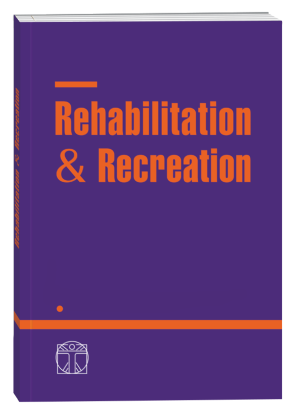FEATURES OF THE FUNCTIONING OF THE MAXILLO-FACIAL REGION AND THE TEMPO-MANDIBULAR JOINT IN PATIENTS WITH BRUXISM AND THE POSSIBILITY OF THEIR CORRECTION BY PHYSICAL THERAPY
DOI:
https://doi.org/10.32782/2522-1795.2024.18.4.1Keywords:
physical therapy, rehabilitation in dentistry, maxillofacial diseases, bruxism, joint dysfunctionAbstract
Purpose is to evaluate the effectiveness of the developed physical therapy program on the functioning parameters of the orofacial zone and the temporomandibular joint as criteria for the effectiveness of the rehabilitation of individuals with bruxism. Material. The control group consisted of 32 people without burdened dental status. Group 1 consisted of 31 people with bruxism, which was corrected with individual relaxing splints. Group 2 consisted of 32 people with bruxism, in whom, in addition to splints, a physical therapy program was applied: therapeutic exercises, massage, postisometric relaxation, kinesiological taping for masticatory muscles, facial muscles, neck, cervical-collar zone, back, shoulder girdle, transcutaneous electromyostimulation of masticatory muscles; autorelaxation sessions according to Schultz; patient education. The effectiveness of the program was evaluated by the dynamics of complaints, results of dental and general examination, measurement of the amplitude of movements of the lower jaw, the “Hamburg test”, the Helkimo index. Results. In patients with bruxism, signs of dysfunction of the maxillofacial area and the temporomandibular joint were identified in the form of numerous complaints of pain and dysfunction of the orofacial area, chewing disorders, changes in the area of the masticatory muscles, the front and lateral surfaces of the neck and the cervical spine, which supported by the results of the examination, measurement of the amplitude of movements of the lower jaw, the protocol of the “Hamburg test”, the Helkimo index. The complex physical therapy program demonstrated a statistically significantly better effect (p<0.05) on the studied indicators compared to the initial data; a decrease in the number of complaints, an improvement in the amplitude of movements of the lower jaw, and a decrease in the severity of temporomandibular joint dysfunction were determined. In patients who received an effect only on the peripheral component of bruxism (individual relaxation splints), an improvement in the studied indicators was determined, which in terms of magnitude was inferior to the effectiveness of the developed program of active functional rehabilitation. Conclusions. In the rehabilitation of patients with bruxism, it is advisable to include measures taking into account and correcting not only local dental, but also general somatic consequences of bruxism, which will improve their quality of life.
References
1. Al-Jewair T., Shibeika D., Ohrbach R. Temporomandibular Disorders and Their Association with Sleep Disorders in Adults: A Systematic Review. J Oral Facial Pain Headache. 2021. No. 35(1). Р. 41–53. doi: 10.11607/ofph.2780.
2. Amorim C.S.M., Espirito Santo A.S., Sommer M., Marques A.P. Effect of Physical Therapy in Bruxism Treatment: A Systematic Review. J Manipulative Physiol Ther. 2018. No. 41(5). Р. 389–404. doi: 10.1016/j.jmpt.2017.10.014.
3. Aravitska M.H., Saienko O.V. The influence of physical therapy on indicators of locomotive syndrome in elderly persons with osteoarthritis of the knee and obesity. Clinical and Preventive Medicine. 2023. 4(26). 6–13. https://doi.org/10.31612/2616-4868.4(26).2023.01.
4. Didokha I.V., Aravitska M.G., Yatsiv Ya.M., Hrecheskyi O.V. Effect of a physical therapeutic intervention on locomotive syndrome in the elderly patients with Parkinson’s disease and sarcopenia. Health, sport, rehabilitation. 2023. 9(1). 55–68. https://doi.org/10.34142/HSR.2023.09.01.05.
5. Goldstein G., DeSantis L., Goodacre C. Bruxism: Best Evidence Consensus Statement. J Prosthodont. 2021. No. 30(S1). Р. 91–101. doi:10.1111/jopr.13308.
6. Jung W., Lee K.E., Suh B.J. Influence of psychological factors on the prognosis of temporomandibular disorders pain. J Dent Sci. 2021. No. 16(1). Р. 349–355. doi: 10.1016/j.jds.2020.02.007.
7. Knibbe W., Lobbezoo F., Voorendonk E.M., Visscher C.M., de Jongh A. Prevalence of painful temporomandibular disorders, awake bruxism and sleep bruxism among patients with severe posttraumatic stress disorder. J Oral Rehabil. 2022. No. 49(11). Р. 1031–1040. doi: 10.1111/joor.13367.
8. Koval N.P., Aravitska M.H. Dynamics of kinesiophobia and physical functioning parameters in the elderly adults with sarcopenic obesity under the influence of the physical therapy program. Clinical and Preventive Medicine. 2023. 4(26). 88–95. https://doi.org/10.31612/2616-4868.4(26).2023.13.
9. Lei Q., Lin D., Liu Y., Lin K., Huang W., Wu D. Neuromuscular and occlusion analysis to evaluate the efficacy of three splints on patients with bruxism. BMC Oral Health. 2023. No. 23(1). Р. 325. doi: 10.1186/s12903-023-03044-5.
10. Manfredini D., Ahlberg J., Lobbezoo F. Bruxism definition: Past, present, and future – What should a prosthodontist know? J Prosthet Dent. 2022. No. 128(5). Р. 905–912. doi: 10.1016/j.prosdent.2021.01.026.
11. Manfredini D., Lobbezoo F. Sleep bruxism and temporomandibular disorders: A scoping review of the literature. J Dent. 2021. No. 111. Р. 103711. doi: 10.1016/j.jdent.2021.103711.
12. Matusz K., Maciejewska-Szaniec Z., Gredes T., et al. Common therapeutic approaches in sleep and awake bruxism – an overview. Neurol Neurochir Pol. 2022. No. 56(6). Р. 455–463. doi: 10.5603/PJNNS.a2022.0073.
13. Nesterchuk N.Ye., Gamma T.V., Korobkova R.M. Characteristics of the quality of life of elderly patients with traumatic damage of the lower jaw as a criterion of the efficiency of rehabilitation intervention. Rehabilitation & Recreation. 2024. No. 18 (2). Р. 20–27. https://doi.org/10.32782/2522-1795.2024.18.2.2.
14. Vavrina J., Vavrina J. Bruxismus: Einteilung, Diagnostik und Behandlung [Bruxism: Classification, Diagnostics and Treatment]. Praxis (Bern 1994). 2020. No. 109(12). Р. 973–978. doi: 10.1024/1661-8157/a003517.
Downloads
Published
How to Cite
Issue
Section
License

This work is licensed under a Creative Commons Attribution-NonCommercial-NoDerivatives 4.0 International License.












